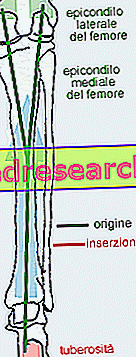
Its imposing tendon joins that of the soleus muscle forming the calcaneal (or Achilles) tendon which is inserted into the calcaneal tuberosity, in the middle third of the posterior aspect of the calcaneus.
With its action it extends the foot (the plantar flexes), rotates it internally, and also participates in the flexion of the leg (being, unlike the soleus, a biarticular muscle). With its contraction it elevates the heel during walking.

It is innervated by the tibial nerve (L4-S1).
ORIGIN Lateral twin: lateral epicondyle of the femur, popliteal plane and posterior portion of the knee joint capsule Medial twin: medial epicondyle of the femur, popliteal plane and corresponding portion of the knee joint capsule |  |
INSERTION In the heel tendon (or Achilles) on the middle third of the back face of the calcaneus | |
ACTION Extends the foot (the plantar flexes) and rotates it internally, contributes to the flexion of the leg | |
INNERVATION TIBIAL NERVE (L4-S1) |
| Upper limb | Lower limb | Trunk | Abdomen | Articles |



